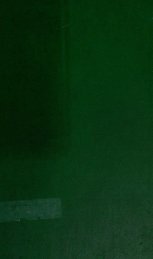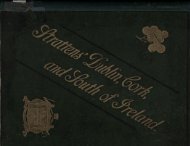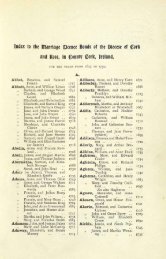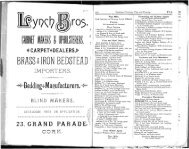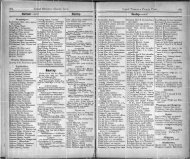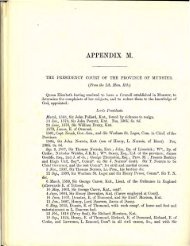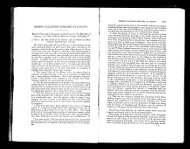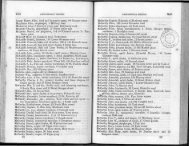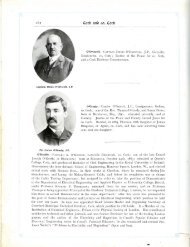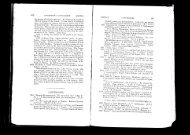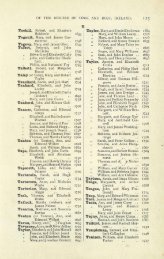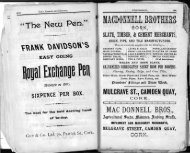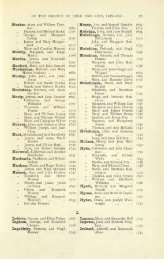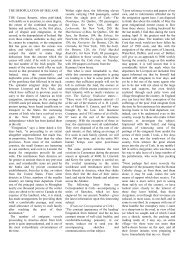BALLYHOOLY CASTLE - Cork Past and Present
BALLYHOOLY CASTLE - Cork Past and Present
BALLYHOOLY CASTLE - Cork Past and Present
Create successful ePaper yourself
Turn your PDF publications into a flip-book with our unique Google optimized e-Paper software.
^u<br />
•<br />
<strong>BALLYHOOLY</strong> <strong>CASTLE</strong> (1905)<br />
<strong>BALLYHOOLY</strong> VILLAGE, LOOKING NORTH.<br />
(/'koto by Col. Grove White, Sept., igo6.)<br />
•<br />
•'<br />
• • • .
<strong>BALLYHOOLY</strong>. 217<br />
I. Rachel Grainger, d. unm. 17 June, 1878.<br />
II. Anne Theodosia, m. George Napier Ferguson, J.P., M.A., Barrister-at-Law, <strong>and</strong><br />
has issue. He d. 4 May, 1902.<br />
ARMS—Arg. on a chevron engrailed gu. between three trefoils slipped vert as many doves<br />
of the field, each holding in its beak an olive branch ppr.<br />
CREST—A boar passant paly of six arg. <strong>and</strong> gu.<br />
MOTTO—Vi et virtute.<br />
SEATS—Finnstown, Lucan, <strong>and</strong> Howth, both Co. Dublin.<br />
A member of the Braithwaite family now owns Ballyheen.<br />
According to Guy, 1907, the farmers on Ballyheen Townl<strong>and</strong>s are Messrs. Christopher<br />
C. Sherlock <strong>and</strong> John Barrett.<br />
Ballyhimock (see Annesgrove).<br />
Ballyhooly.<br />
BY REV. J. F. LYNCH.<br />
Dr. Joyce (Irish Names of Places, i., 516) says that abhall or ubhall<br />
signifies both an apple <strong>and</strong> an apple tree, <strong>and</strong> that the ancient Irish form,<br />
as found in the Zeuss MSS., is aball, which corresponds with the Anglo-<br />
Saxon appel, English apple. Dr. Joyce explains Ballyhooly as town of<br />
the apple-ford, being from Irish Baile atha ubhla, <strong>and</strong> says that the place<br />
is named Ath-ubhla, or ford of the apples, in Book of Lismore. In Social<br />
Irel<strong>and</strong>, ii., 154, Dr. Joyce says that the apple (ubhall) was as much cultivated<br />
<strong>and</strong> used in old times as at present, <strong>and</strong> that apples, when gathered,<br />
were hoarded up to preserve them as long as possible, <strong>and</strong> that the<br />
Cuidees at the great festivals were permitted to indulge in apples. He<br />
also quotes from O'Donovan that the word abhall was used in the best<br />
<strong>and</strong> most ancient Irish MSS. to denote the apple tree, <strong>and</strong> ubhall its<br />
fruit, but that this distinction has long ceased to be observed.<br />
Dr. Joyce (Irish Names, i., 354) says that "there are several Irish<br />
words for the different kinds of fords, of which the most common is ath,<br />
cognate with Latin vadum. In the various forms ath, ah, augh, agh. a, &c,<br />
IL forms a part of hundreds of names all over Irel<strong>and</strong>."<br />
The valley of the Blackwater was renowned for its apples <strong>and</strong> cider.<br />
With regard to the word baile, Professor Rhys (Hibbert Lecturer) says<br />
that it now means a place, but originally signified an enclosed place, <strong>and</strong><br />
that it is a loan word not to be severed from the English bailey.<br />
At Ath Ubhla the great road connected with the white cow, according<br />
to the legend of <strong>Cork</strong> Harbour, crossed the great river of <strong>Cork</strong>, <strong>and</strong> passed<br />
from Great Isl<strong>and</strong> to Ath Ubhla, thence to the Funcheon at Aghacross,<br />
to the Red Gap, to Cleghile near Tipperary, to Ath Fiacla, to Athassel<br />
on the river Suir, named Ath Nemthem in Silva Gadelica, to Cashel of<br />
the Kings.<br />
In O'Hanlon's Life of St. Mochudu it is stated that St. Mochuda built<br />
a -Jiurch at Athassel, which was granted to him by the King of Muscraighe<br />
Thire. Cill Fiacla, a little north of the ford of Ath Fiacla, is mentioned in<br />
Tripartite Life of St. Patrick as having been built by St. Patrick. The<br />
i
2l8 HISTORICAL AND TOPOGRAPHICAL NOTES.<br />
moat beside Cill Fiacla, or " Church of the Tooth," appears to have<br />
been named Dun Sige. North of the town of Tipperary, <strong>and</strong> beside the<br />
track of the old road, are two or three very small mounds named Cloch<br />
Breige, literally "stone-heap of falsehood."<br />
Lady Gregory, in her Gods <strong>and</strong> Fighting Men, says that the three<br />
cows of <strong>Cork</strong> Harbour, reel, white <strong>and</strong> black, respectively, belonged to<br />
Manannan Mac Lir. Manannan is extended form of Manu, thus the Irish<br />
name for Isle of Man is Inis Manann, or " Isl<strong>and</strong> of Manu," <strong>and</strong> for<br />
Manannan's connection with Isle of Man <strong>and</strong> with places in Irel<strong>and</strong>, see<br />
Hibbert Lectures, where Rhys quotes from O'Donovan <strong>and</strong> Cormac's<br />
Glossary.<br />
The chief fort of the O'Duggans was named Dun Manann, <strong>and</strong> it was<br />
most likely near Loch Luingi, <strong>and</strong> not far from Doneraile.<br />
According to O'Heerin,<br />
" Triath u Fear Muighi na mur ccorr<br />
O' Dubhagain Diun Manann,<br />
Foireann gaoil na sed soraidh,<br />
O' Caoimh, gecc a Gle<strong>and</strong>omhain."<br />
" The lord of Feara Muighe of smooth mounds,<br />
O' Dubhagain of the Fort of Man,<br />
Tribe of relations of prosperous wealth,<br />
O' Caoimh, branch of Glanworth."<br />
The territory of O'Duggan (O'Dubhagain) extended from Glais Muilinn<br />
Mairteil (" Stream of Mill of Mairtel") most likely Abha na g Caorach<br />
(Sheep-river) to Loch Luingi (mentioned in Tripartite Life of St. Patrick),<br />
<strong>and</strong> to Gleann nan Dibergach ("Valley of Robbers") on Moin Mhor<br />
("Great Bog"), near Mallow. (Lives from Book of Lismore, p. xxxvi.)<br />
In Annals of Four Masters, under 627 A.D., we read: "The battle of<br />
Ath Abhla, where Dicul, son of Fergus, was slain by the Munstermen."<br />
O'Donovan in note says that Ath Abhla has not been identified, <strong>and</strong> quotes<br />
from Ann. Ult., "A.D. 63i,Bellum Atho Aubla, in quo cecidit Diciull Mac<br />
Fergusa Tuile la Mumain."<br />
In Chronicum Scotorum, at 632 A.D., we read:"Bellum Atha Abla in<br />
quo cecidit Dicull Mac Fergusa Tuile la Mumain."" Hennessy identifies<br />
Ath Abla with Ballyhooly ford.<br />
In Chronicum Scotorum, under A.D. 1122, we read : " A great camp by<br />
Toirdhealbhach (King of Connaught) in Ur-Mumhain, from Lammas till<br />
the festival of Brigid, <strong>and</strong> he plundered from that camp, at one time,<br />
Tir-Conaill, <strong>and</strong> another time as far as Moin Mor, <strong>and</strong> to Glenn Maghair,<br />
or "Valley of Maghar," now Glanmire, near <strong>Cork</strong>.<br />
In Gaelic Journal, 1904, p. 671, there is a reference to the celebrated<br />
races of Ballyhooly, <strong>and</strong> the following note:—" B'le ath' Ubhal, B'le<br />
Ath' Ubhla, Ballyhooly, Co. <strong>Cork</strong>. The races of Ballyhooly must have<br />
been famous in those days. Mention is also made of them in a song<br />
which was composed about a skirmish that happened in connection with<br />
the tithe troubles at Gort Ruadh."<br />
Windele (Journal, see ser. iii. 379) says that at Ashfield is a st<strong>and</strong> house<br />
belonging to a race ground.
<strong>BALLYHOOLY</strong>. 21$<br />
In the Life of St. Carthach, or Mochuda, given by the Very Rev.<br />
Canon O'Hanlon (Lives of Irish Saints, iv., p. 240, et seq.), it is stated<br />
that when Mochuda was travelling through Munster he came to a river<br />
formerly called Nemphe, but at the time the Life was written the river<br />
was named Abhainn mhor, now the Blackwater. Mochuda seeing an<br />
apple swimming on the river, took it <strong>and</strong> brought it towards home. The<br />
place was subsequently calledt in consequence of the finding of the apple<br />
in the ford, Ath Ubhla, or "ford of the apple." On the way northwards<br />
along the great road, the charioteer of Mochuda asked him for the apple,<br />
but Mochuda stated that by means of the apple would be cured the<br />
withered h<strong>and</strong> of the beautiful daughter of Cuanna Mac Cailein, King of<br />
Feara Maighe Fene. In Chronicum Scotorum, A.D. 629, is noted the death<br />
of Cailcin, son of Dima, from Liathmuine in Feara Maighe. Mochuda<br />
saw Flannaid, or "ruddy one," daughter of Cuanna, playing with some<br />
young girls in front of her father's residence, <strong>and</strong> having her right h<strong>and</strong><br />
withered <strong>and</strong> hanging helplessly at her side. Mochuda called Flannaid<br />
to him, <strong>and</strong> said to her, " Take this apple," <strong>and</strong> Flannaid having extended<br />
her left h<strong>and</strong>, Mochuda told her to reach forth the right h<strong>and</strong>, which she<br />
did, <strong>and</strong> found it restored to strength while thus receiving the apple from<br />
Mochuda. Flannaid refused to accept as husb<strong>and</strong> any one of the princes<br />
of Munster, <strong>and</strong> accompanied Mochuda to Raithin, in King's Co., where<br />
she lived in a nunnery, <strong>and</strong> afterwards accompanied Mochuda to Lismore, 1<br />
<strong>and</strong> founded Cells at Forth <strong>and</strong> Cluain Dablam on the Blackwater, places<br />
which were bestowed upon her by Cuanna Mac Cailcin. Various tales,<br />
now lost, must have been told in Fermoy; concerning Flannaid, for in the<br />
Journal, 1897, p. 86, we read : "This is similar to the spell laid on Cuanan<br />
(Cuana Mac Cailcin) <strong>and</strong> his beautiful daughter, who are confined to their<br />
palace in the Blarney lough, 2 as well as Giroid Iarla in Lough Gur, together<br />
with various other celebrated personages, who are not likely to be<br />
freed from their enchantment in this age, so devoted to sordid gain."<br />
Some particulars concerning Cuana Mac Cailcin have been already<br />
given, who, according to Four Masters, died A.D. 640. The wife of Cuana<br />
was named Ruithchearn (O'Curry's Lectures, p. 590), <strong>and</strong> she was the<br />
daughter of Aedh Bennan, King of West Munster about A.D. 600. In<br />
the Book of Leinster there is a sketch of the tale of the elopement of<br />
1 Todd (P.R.I.A., 1870, p. 20) says that in "Book of Fermoy" there is "a tract<br />
headed Indarbha Mochuda ar Raithin, "banishment of Mochuda'out of Raithin." It<br />
begins : Mochutta mac Finaill, do Ciaraigi Luacra a cenel. " Mochuda, son of Finaill, of<br />
Ciarraighe Luachra (now Kerry) was his family." This is a curious <strong>and</strong> valuable account<br />
of* the banishment of St. Mochuda from Raithin, now *Rahan, near Tullamore, King's<br />
County, <strong>and</strong> his settlement at Lismore, where he founded a celebrated school <strong>and</strong><br />
episcopal see in the seventh century. In "Chronicum Scotorum," A.D. 635, is following<br />
entry :—" Expulsion of Carthach, i.e., Mochuda, i.e., Mochta, son of Firaull<br />
jFinall), from Raithin, in diebus Paschce," <strong>and</strong> at A.n. 636 is following entry:—<br />
'Quies of Mochta of Raithin, on the 2nd of the Ides of May." Mochta is a shortened<br />
form of Mochuda, owing to first syllable being strongly accented.<br />
2 Blarney (Blarna, Gen. Blarnan) belonged to the race of Cairbre Muse before its<br />
occupation by the Mae Carthys, who were from County of Tipperary. O'Donovan (Sup.<br />
to O'Reilly's Dictionary) savs :—"Dun na sciath, now Dunnaskeagh, a townl<strong>and</strong> in the<br />
Parish of Rathlvnin, in the barony of Clanwilliam, County of Tipperary, where Carthach,<br />
the ancestor of the McCarthys resided in 1043." Rathlynin was in_territory of Muscraighe<br />
j^eogain, the old name being Magh Breogain. Breogan is eponym of Brigantes, or<br />
tfrythons, the second great race of Celts who reached the British Isles.
22o HISTORICAL AND TOPOGRAPHICAL NOTES.<br />
Ruithchearn with Cuana. Aedh Bennan had also a daughter named Mor, 3<br />
the heroine of a strange series of adventures recorded in Book of Fermoy.<br />
Inis Fadthlerin (Inisfallen) at Killarney is stated in P.R.I.A., 1870, p. 115,<br />
to have been named from Faighlen or Faighlenn (Faithlenn), son of Aedh<br />
Bennan, of the race of Core Mac Luigdech.<br />
Maelduin was also name of a son of Aedh Bennan, <strong>and</strong> he is mentioned<br />
in tale of the battle of Magh Rath, A.D. 637, <strong>and</strong> in Chronicum Scotorum,<br />
A.D. 639, Maelduin, son of Aedh Bennan, is stated to have been defeated<br />
by Aenghus Liathana of Glanworth, in battle fought at Cathair Chinn<br />
Chon, or fort of the head of the hound, now named Cathair Ghiolla Mhoir,<br />
close to Lough Gur, which in Book of Rights is stated to be one of the<br />
Royal Forts. Giolla Mor is mentioned in many tales, <strong>and</strong> the name<br />
Cahergillamore, from which Lord Guillamore takes his title, occurs in a<br />
State Paper of 13th century, when the place was attached to the Manor of<br />
Glenogra. This fort is marked on new Ordnance Map, <strong>and</strong> close to it is a<br />
large pillar-stone. It will now be necessary to deal with the names of the<br />
Blackwater.<br />
Camden thinks that the Dabrona of Ptolemy (130 A.D.) is river Lee,<br />
but it is better to regard the Dabrona as identical with the Blackwater.<br />
Dabrona means river, <strong>and</strong> may be connected with the words Dobhar <strong>and</strong><br />
Dur, owing to the interchange of abh with u. In several old tales the<br />
Blackwater is named Nem, which means bright, <strong>and</strong> is same as Nim,<br />
Niamh, or Niab, <strong>and</strong> I think that Niab or Nib is the oldest form. In Silva<br />
Gadelica <strong>and</strong> Lay of Oisin on Tir na Nog the form Niamh occurs, but in<br />
Feast of Bricrin, p. 35, the name is Niab, daughter of Celtchar Mac<br />
Uthechair. Late in the Irish historic period Niamh was a favourite female<br />
name. Nemphe, which is the name for Blackwater in the Life of Mochuda,<br />
is merely an extended form of Nem. In Lady Gregory's Gods <strong>and</strong> Fighting<br />
Men, there is an Irish tale, in which the Nem <strong>and</strong> Laoi (Lee) are stated<br />
to be two of the twelve chief rivers of Irel<strong>and</strong>. From the word Nem is also<br />
derived Nemid or Neimheadh, who, as son of Agnoman, has a connection<br />
with the Great Isl<strong>and</strong> of <strong>Cork</strong> Harbour, which was named Ard Oileain<br />
Neimheadh. (See Keating's History, <strong>and</strong> Rhys' Hibbert Lectures.) From<br />
Nem is also Nemid Mac Sruibchenn, King of the Erne, <strong>and</strong> second hus<br />
b<strong>and</strong> of the wife of Conaire Mor, the father of Cairbre Muse, C. Baschain,<br />
<strong>and</strong> C. Riada. Nemid Mac Sruibchenn <strong>and</strong> Ingcel are stated to have<br />
slain Conaire, <strong>and</strong> Nemid was slain by the Cairbres in the battle of Genn<br />
Febrat (Ballyhoura Mountains). For particulars see O'Flaherty's<br />
3 Mor is generally termed Mor Mumhan, i.e., Mor of Minister. In " Chronicum<br />
Scotorum," A.D. 633, is following entry:—" Bas Moire Human," ''death of Mor of<br />
funster." Mor was a favourite Irish name. Mor, wife of Brian Boru, was mother of<br />
Murrough, Conor, <strong>and</strong> Flann. In " Silva Gadelica," p. 547, it is stated that Mor<br />
Mumhan was wife of Finghin Mac Aedha, King of Munster, <strong>and</strong> mother of Deog, wife<br />
of Laighnen Mac Colmain, <strong>and</strong> afterwards wife to Guaire Aidhne Mac Colmain, King of<br />
Connaught. According to the legend of Mor (" Book of Fermoy"), she was wife of<br />
Cathal, son of Fionguine, son of Cu-gan-mathair, but Cathal Mac Fionguine died A.£>.<br />
737, as noted by Todd. Aedh Bennan, father of Mor Mumhan, from whom are the<br />
family of O'Moriarty of Kerry, died in 619. Finghin, son of Aedh Dubh, was King 01<br />
Desmond (604^19), <strong>and</strong> brother of Failbhe Flann, ancestor of the Mac Carthy who was<br />
King of Munster (627-636). The O'Sullivans .ire traced to Sullivan, eighth in descent from<br />
Finghin Mac Aedha, <strong>and</strong> the O'Keefles are traced to Caomh, fourth in descent from<br />
Cathal Mac Fionguine. See Genealogical Table in " Battle of Magh Rath."<br />
-
BALLYHOQLY. 221<br />
Ogygia, Silva Gadelica, Hibbert Lectures, <strong>and</strong> Togail Bruden Da Derga,<br />
which has been translated by Dr. Whitley Stokes.<br />
To the root Nem must also be referred Nemthenn, the old name of<br />
Athassel, <strong>and</strong> the source of Nephin, a mountain in Co. Mayo. Ath<br />
Nemthenn in Tipperary was the northern boundary of the territory of<br />
Museraighe Breoghain, who were named from Cairbre Muse. For a<br />
folk's etymology of Nephin (Nemthenn) see Bodleian Dinnshenchas, p. 33,<br />
where the name is stated to be neim tenn, or " strong poison."<br />
The present Irish name for the Blackwater is Abhainn Mhor, or " great<br />
river," <strong>and</strong> it is named Abhuin Mhor by Edward Walsh in his Mo<br />
Chraoibhin Cno ("My Cluster of Nuts").<br />
" My heart is far from Liffey's tide, <strong>and</strong> Dublin town;<br />
It strays beyond the southern side of Cnoc Maol Donn,<br />
Where Ceapa Chuinn hath woodl<strong>and</strong>s green,<br />
Where Abhuin Mhor's waters flow.<br />
Where dwells, unsung, unsought, unseen,<br />
Mo Chraoibhin Cno.<br />
Low clustering in her leafy green,<br />
Mo Chraoibhin Cno."<br />
Dr. Joyce says that abhainn, which corresponds with Sanskrit avani,<br />
is in much more general use than abh, <strong>and</strong> it is the common appellative in the<br />
language for a river. The Abhainn Mhor of Co. <strong>Cork</strong> is often called<br />
Broadwater by early Anglo-Irish writers, <strong>and</strong> the word abhain has, according<br />
to Dr. Joyce, three different forms in the genitive, viz., abhann, abhanna<br />
<strong>and</strong> aibhne. Abhann or abh<strong>and</strong> also occurs as nominative, thus in Mesca<br />
Ulad, p. 14, " Dar Findsruth ris a n-apar ab<strong>and</strong> h Cathbath," "across<br />
Findsruth (bright river), which is called the river of O'Cathbad " (Owen<br />
O'Coffey or Nenagh river, in Co. Tipperary). In Silva Gadelica, p. 188,<br />
is mentioned Abhann Deise, or " river of the two persons."<br />
Dr. Joyce sayts that there are many streamlets in the South of Irel<strong>and</strong>,<br />
but none in the North, named Abh. Awbeg, or " little ab," is near Done-<br />
raile, <strong>and</strong> Abh na gcaerach is the sheep river of Fermoy district, <strong>and</strong><br />
Finnow, or "bright ab," is near Ballyclough.<br />
The Blackwater is termed Awniduff by Spenser.<br />
" There was the Liffy rolling down the lea,<br />
The s<strong>and</strong>y Slane, the stony Aubrion;<br />
The spacious Shenan spreading like a sea;<br />
The pleasant Boyne, the fishy fruitful Ban.<br />
Swift Awniduff, which of the English man<br />
Is caF de Blackwater, <strong>and</strong> the Liffar deep;<br />
Sad Trowis, that once his people over-ran ;<br />
Strong Alio tombling from Slewlogher steep,<br />
And Mulla mine, whose waves I whilom taught to weep."<br />
Callanan says : " Avondu means the Blackwater (Avunduff of Spenser).<br />
It rises in a boggy mountain called Meenganine (in* Co. Kerry), <strong>and</strong> dis<br />
charges itself into the sea at Youghall. For the length of its course <strong>and</strong><br />
the beauty <strong>and</strong> variety of scenery through which it flows, it is superior,<br />
I believe, to any river in Munster. It is subject to very high floods/'
22 2 HISTORICAL AND TOPOGRAPHICAL NOTES.<br />
The following is the opening verse of Callanan's " Sweet Avondu," but<br />
Avondu has been taken from Spenser :—<br />
" On Cleada's hill the moon is bright,<br />
Dark Avondu still rolls in light;<br />
All changeless is that mountain's head,<br />
That river still seeks ocean's bed.<br />
The calm blue waters of Loch Leane<br />
Still kiss their own sweet isles of green,<br />
But where's the heart as firm <strong>and</strong> true<br />
As hill, or lake, or Avondu?"<br />
From O'Heerin's Topographical Poem I take the following, in which<br />
there is mention of the Abhainn Mor :—<br />
" Fuair O' hAoda do brond ba,<br />
Muscraighe leathan Luachra;<br />
Fine glan fhuinn an ghloir ghil,<br />
Imon Abhainn Moir Maighrigh."<br />
"Oh Aodha, who bestowed cows, has got<br />
The wide Muscraighe Luachra;<br />
A tribe of fine l<strong>and</strong> <strong>and</strong> high renown,<br />
About the salmon-full Abhainn Mor."<br />
About a mile south of Ballyhooly is a well named from St. Brendan the<br />
Navigator, <strong>and</strong> in connection with Tulach Mhin I forgot to mention in<br />
article on Aghacross that in the Irish Life of St. Finnbarr, published in<br />
Journal, Domangen, 4 brother of Brendan, <strong>and</strong> Fintan are connected<br />
with Tulach Mhin. Windele says that there is a holy well, Tobar Breuka,<br />
near Ballyhooly, whose waters are good for headaches <strong>and</strong> sore eyes.<br />
He makes mention of the Glenna Bo ("Valley of the Cow") woods,<br />
forming part of the demesne grounds of Castle Hyde, <strong>and</strong> he also refers<br />
to Coolnamuckee, or "the pig's corner," in the Ballyhooly district.<br />
There are various tales in which the muc is mentioned. The muc named<br />
Beo, slain by Finn, according to the Boyish Exploits, was killed beside<br />
Sliabh na Muice, near. Tipperary, on the road the course of which through<br />
Fermoy we have marked <strong>and</strong> named Bothar Bo Finne. Borlase (Dolmens<br />
of Irel<strong>and</strong>, iii., 90) says that Windele (Topog. of Desmond, p. 151) hlas<br />
attached a legend to Glenna Bo, near Ballyhooly, <strong>and</strong> according to Silva<br />
Gadelica there was a Loch Bo on the Ballyhoura mountains. The Rev.<br />
4 Canon O'Hanlon ("Lives of Irish Saints," v., 400) says:—"According to St.<br />
Brendan's "Irish Life," he had a brother who was a bishop named Domanigen, <strong>and</strong><br />
whose feast has been assigned to the 2Qth April, while he had a sister named Briga, or<br />
Brigh, said to have been of Enach Duin (in Co. Galwav)." In note to Domanigen,<br />
Canon O'Hanlon savs :—"Thus at the third of the Kalends of May, the Calendar quotes<br />
him as follows :—Domanigen, Bishop of Tuaim Muscraighe, i.e., son of Fionlugh,<br />
brother of Brendan, son of Fionlngh, who was of the race of Ciar, son of Fergus, son<br />
of Rudraighe.' In vol. iv., p. 546, Canon O'Hanlon says :—" In the published<br />
Martyrology of Tallagh, at the 29th April, is found the simple entry :—' Domangin or<br />
Tuaim Muscraidhe.' In the Boll<strong>and</strong>ists' collection, referring to the same Calendar, they<br />
have Domongenus, Episcopus de Tuaim Muscraig. This place is stated ( c Donegal<br />
Martyrology,' pp. 112-113; Reeves' 'Ecclesiastical Antiquities of Down, Connor, <strong>and</strong><br />
Drornore,' pp. 152-377) to be identical with Tomes, Barony o f West Muskerrv, Co. <strong>Cork</strong>."<br />
Tobar Breauka, near Ballyhoolv, seems to have been named from a saint who i- s .»<br />
perhaps, Brig, Briga, or Brega, sister of Brendan <strong>and</strong> Domangen The name Domangen<br />
occurs on one of the recently discovered Clonakilty Ogham stones.<br />
*
DOORWAY ON SOUTH SIDE OF OLD <strong>BALLYHOOLY</strong><br />
CHURCH,<br />
{Photo by Col. Grove White, Sept., 1906.)<br />
ST. BRENDAN'S HOLY WELL NEAR <strong>BALLYHOOLY</strong><br />
(Photo by Col. Grove White, Sept., igo6.)
*<br />
:<br />
• • • ; • - • • . - .<br />
<strong>BALLYHOOLY</strong>. 223<br />
Patrick S. Dinneen (Irofo Dictionary), under Bothar, says that Bothar Bo<br />
Finne, or "Road of the White Cow," was an Irish name for the Milky<br />
Way. For another reference to Milky Way, see Hibbert Lectures, p. 300.<br />
Windele says that Cullinagh, or holly district, is near Coolnamucky, being<br />
to the east, <strong>and</strong> that west of Hollymount is a large square fort.<br />
The parish of Ballyhooly is also named Aghultie by Lewis, which is the<br />
name he gives the Prebend in his account of Cloyne. Aghultie is from the<br />
Irish Ath Ubhla, which became Athull, Aghuld, Aghultie, <strong>and</strong> so thus the<br />
old name of the ford is preserved. Colonel Grove White remarks that<br />
the castle was built on the rock for the purpose of guarding the ford, <strong>and</strong><br />
instructed by his military knowledge, I assume that the Irish had also a<br />
fort on this rock for the same purpose, <strong>and</strong> a very important fort it must<br />
have been owing to the importance of the great road which here crossed<br />
the great river of Feara Maighe Fene.<br />
The taxation of the Prebends 5 of Cloyne is given in the Ecclesiastical<br />
Taxation of 1302, <strong>and</strong> may here be given :—•<br />
Prebend of the Dean of Cloyne, Master Philip de Soegda, the Chapel<br />
of Carrygomath.<br />
Prebend of the Precentor, William de Valle, the Church de Kylmodosnog.<br />
Prebend of the Chancellor, Richard de Barri, the Church of Glennowyr,<br />
value 28! marks, tax 38s.<br />
Prebend of the Archdeacon, Master Maurice O'Sullevan, the Church de<br />
Athcros Neynan, <strong>and</strong> a small portion of Clenor, value 50s., tax 5s. The<br />
jurisdiction of the same is valued at 10s marks, <strong>and</strong> tax is 1 mark.<br />
Prebend of Master Richard O'Carran, the Church of Athull (Ath Ubhla),<br />
value 16s. 8d., tax 2od.<br />
Prebend of Master Gilbert Mac Abram, portion of Wissert <strong>and</strong> portion<br />
of Drummor, value 40s., tax 4s.<br />
Prebend of Master Charles Odonkeda, the Church of Subulter, value<br />
2 marks, tax 2s. 8d.<br />
Prebend of Master John Ohonecan, the Church of Cool <strong>and</strong> Bregwach,<br />
value 4 marks, tax 5s. 4d. %<br />
Prebend of Master David O'Sullevan, the Church of Ballycananych,<br />
value 2\ marks, tax 4od.<br />
Prebend of Master Philip Obrodere, the Church of Cahirulton, value 3<br />
marks, tax 4s.<br />
Prebend of Thomas Osithechan, the Church of Kilcredan, value 2\<br />
marks, tax 40&<br />
Prebend of Master Philip Olignovan, the Church of Iniscarra <strong>and</strong><br />
Mathehy, value 20s., tax 2s.<br />
Taxation of the Priory of St. Thomas the Martyr, near Buton (Butte-<br />
vant), in demesne, cultivated l<strong>and</strong>s, issue of animals <strong>and</strong> of a mill.<br />
In connection with the name Dun Manann, which is very important,<br />
Dr. O'Donovan says that the name is now obsolete in the Fermoy district,<br />
but that it was evidently the name of the chief residence of O'Dubhagain,<br />
who possessed about the northern half of the territory of Feara Muighe<br />
5 Lewis says that the Chapter of Cloyne consists of a dean, precentor, chancellor,<br />
treasurer, archdeacon, <strong>and</strong> the 14 prebendaries of Donaghmore, Aghultie, Inniscarra,<br />
Bneown, Kilmacdonoucrh, Cahirultan, Killenemer, Glenore, or Glanworth, Cooliney,<br />
Ballyhay, Coole, Kilmaclenan, Subulter, <strong>and</strong> Lackeen.
*<br />
s<br />
2 24 HISTORICAL AND TOPOGRAPHICAL NOTES.<br />
•<br />
Feine, being seated between O'Keeffe <strong>and</strong> the Ui Fidhgenti. There is also<br />
another reference to Manannan in O'Heerin's Poem, in which, I think,<br />
the reference is misunderstood by O'Donovan :—<br />
".Muintir Baire an bhrogha ghil,<br />
Do Clannaibh Fothaidh arrocothigh;<br />
O'Baire ar thir na tuinne,<br />
Ca haille min Manainne."<br />
".Muintir Bhaire of the fair fort,<br />
Of the race of the warlike Fothadh ; *<br />
O'Baire is over this l<strong>and</strong> of the sea,<br />
Is the plain of Manainn fairer?"<br />
O'Donovan thinks that Magh Manainne is the plain in Fermoy on<br />
which Dun Manann was erected, but it seems to me that here Magh<br />
Manainne must be Magh Mor, or "great plain," called also Magh Mell,<br />
or " pleasant plain," <strong>and</strong> which in numerous tales is connected with<br />
Manannan. Muintir Bhaire is a tribal district in the parish of Kilcroghane<br />
in West <strong>Cork</strong>. It is not easy to trace those things of old to their true source,<br />
<strong>and</strong> at every step we make we are liable to fall. The Teutons have been<br />
working at their tales since the year 1555, when Olaus Magnus published<br />
his Historia gentium Septentrionalium, <strong>and</strong> very little work has yet been<br />
done by the Celts in Irel<strong>and</strong>, <strong>and</strong> the amount of work that has to be done<br />
in the Celtic field is simply appalling, but now as we have begun at Fear a<br />
Maighe Feine <strong>and</strong> Duthaigh Ealla, we shall, I hope, keep at work in these<br />
important districts, comparing Irish name with Irish name, <strong>and</strong> Irish tale<br />
with Irish tale, <strong>and</strong> the old things of Irel<strong>and</strong> with the old things of other<br />
l<strong>and</strong>s, <strong>and</strong> thus<br />
".We shall tread the dust of ages.<br />
Musing dream-like on the past,<br />
Seeking on the broad earth's pages<br />
For the shadows time hath cast;<br />
Waking up some ancient story,<br />
From each prostrate shrine or hall,<br />
Old traditions of a glory<br />
Earth may never more recall."<br />
-<br />
Ballyhooly (Aghultie) Parish.<br />
Sheet 34, 6-inch O.S., <strong>and</strong> Sheet 176, inch O.S.<br />
Parish of Ballyhooly. Barony of Fermoy.<br />
FIANTS OF ELIZABETH, R.O.D.<br />
(B.E.P under " Roche—Viscount Roche of Fermoy.)<br />
William of Ballyhowlyt was the fifth son of Da'vid Roche, Lord Roche,<br />
surnamed "the Great," who sat in Parliament as Viscount Roche of Fer<br />
moy, in the reigns of Edward IV. <strong>and</strong> Henry VII.<br />
6762 (5468). Pardon to Ullick fitz Wm Roche, of Ballyhewlye, gent.;<br />
James fitz John Roche; Redmund fitz Theobald Roche; Rob fitz John<br />
Shynane & Edm. Shynane, of same, yeoman, Feb., 1602.<br />
Ballyhooley, 2 plowl<strong>and</strong>s, formed part of a large grant of l<strong>and</strong> from<br />
James I. to David Lord Roche, Viscount Fermoy, on his surrender of<br />
the same to the King. 16 December 9, James I. (Patent Rolls, James I.)<br />
*<br />
r
<strong>BALLYHOOLY</strong> (AGHULTIE) PARISH. 225<br />
Sylvanus Spenser married the eldest daughter of David Nagle, of<br />
Monanimy, in the Barony of Fermoy <strong>and</strong> County of <strong>Cork</strong>, by his wife,<br />
Ellen Roche, daughter of William Roche, of Ballyhowly. Sylvanus died in<br />
1638.<br />
*<br />
The mother of the statesman, Edmund Burke, was a Nagle, the gr<strong>and</strong>niece<br />
of Sylvanus Spenser's wife. The orator may have been called<br />
Edmund, after the poet. He passed a portion of his childhood in the<br />
parish of Monanimy. (Gibson i., 309.)<br />
Thomas Hayines, Ballyhooly, 24, was taken prisoner by the Irish<br />
(in 1641), who carried him to the castle of Dromineene, where he saw<br />
O'Callaghan wearing arms. (Journal for 1906, p. 22, " English Settlement<br />
in Mallow," by Henry F. Berry, I.S.O.)<br />
The latter end of the year (1644) passed over in treaties, little being<br />
done in this province till the beginning of 1645, when the Earl of Castlehaven,<br />
at the head of five thous<strong>and</strong> foot <strong>and</strong> one thous<strong>and</strong> horse, took<br />
most of the strongholds in this country, as Cappoquin, Mitchelstown,<br />
Ballyhooly, &c. (Smith, II., 87.)<br />
The Survey <strong>and</strong> Distribution Book (circa 1657) gives: Ballyhooly,<br />
Conra <strong>and</strong> Castle Blaky, Crown l<strong>and</strong>s, 3,478a. 3r. op; Sir Richard Aidworth,<br />
lessee. (P.R.O., Irld.)<br />
Index Testamentorum olim in Registro Corcagiae, 1600^1802. No.<br />
107. Nash, Andrew, of Ballyhooly. Fifth Book, page 711. (Journal<br />
for 1897, p. 310.)<br />
Smith (pub. 1750) states :—" The opposite side of the river is bounded<br />
by a part of Nagle's mountains, which are here covered with wood, but<br />
was formerly a forest of much greater extent named Ballyhooly, from a<br />
castle of the Roches near those woods, which castle came on their forfeiture<br />
to Sir Richard Aldworth. (I. 317.)<br />
George Stannard, of Ballyhooly, Co. <strong>Cork</strong>, d. 1749, leaving issue<br />
Eaton <strong>and</strong> Aldworth, of Ballyhooly, who d. 1756. (See " Stannard,"<br />
Burke's F.R.)<br />
Crofton Croker, in his Researches in the South of Irel<strong>and</strong>, pub 1824,<br />
p. 130, states:—"Two miles beyond Cregg is Ballyhooley, an inconsiderable<br />
village, dignified by the ruins of another <strong>and</strong> more extensive<br />
castle of the Roches st<strong>and</strong>ing on a rock, with the present parish church<br />
<strong>and</strong> the remains of the ancient one—a combination seen to great advantage<br />
from Convamore, the domain of Lord Ennismore, whence it affords<br />
an excellent subject for the pencil, as these structures give a poetic relief<br />
to the massive richness of the surrounding wood, which overhangs the<br />
winding course of the river."<br />
Lewis (pub. 1837) states:—"A parish containing 2,297 inhabitants, 1<br />
of which 533 are in the4'illage; comprises 5,185 statute acres, as applotted<br />
under the Tithe xAct, <strong>and</strong> valued at ^4,616 per annum.<br />
"The l<strong>and</strong> on the south side of the river is chiefly mountain pasture,<br />
forming part of the Nagle mountains, <strong>and</strong> based on a sub-stratum of<br />
brownstone, <strong>and</strong> that on the north side has a good limestone soil.<br />
"The system of agriculture is improved, but is still very imperfect.<br />
Lime is almost exclusively used for manure. There is an abundance of<br />
turf, which is drawn from the south of the Blackwater at a distance of<br />
1 In l8 755 population of parish was 711; in 1881, 682; in 1908, 636.<br />
*<br />
a<br />
*5
226 HISTORICAL AND TOPOGRAPHICAL NOTES.<br />
two miles from the village. Limestone abounds, <strong>and</strong> great quantities<br />
are procured for building <strong>and</strong> burning, &c."<br />
Mr. James Byrne, J. P., of Walls town Castle, Castletownroche, writes :<br />
"The legend of the derivation of the name of Ballyhooly. There is an<br />
ancient tree st<strong>and</strong>ing near the entrance to Convamore demesne, known as<br />
the CfiArm Corh.Acc.A or tree of power. The legend has it that St. Patrick<br />
<strong>and</strong> a prince of Munster met under its branches, but that the Saint found<br />
great difficulty in converting the prince from paganism. After much<br />
argument, the prince agreed to adopt the Christian doctrine, on condition<br />
that St. Patrick performed certain miracles, one being that he would offer<br />
up the Holy Sacrifice unassisted by a clerk, the Saint being alone.<br />
" To this the Saint agreed, <strong>and</strong> the responses were given from the interior<br />
of the tree. The second proof of the Saint's power, he dem<strong>and</strong>ed, was<br />
that the tree overhead should bear apple blossoms, <strong>and</strong> in a moment the<br />
"tree of power," although apparently an ash, was covered with apple<br />
blossoms; hence the place was called " Blagh uile," or the blossom of the<br />
apple.<br />
"The Crann Cbmaita, pronounced ' Cronn Cochta,' is in good preservation<br />
still, <strong>and</strong> I heard many years ago that when one of the Lords<br />
Listowel was making his new avenue, he gave strict injunctions not to<br />
interfere with it."<br />
Mr. James Byrne writes again on 6th November, 1904:—"I passed<br />
by Ballyhooly yesterday, <strong>and</strong> on looking out for the Cf^nn CottiACCA I<br />
was sorry to find it had disappeared. Although it braved the storms of,<br />
perhaps, a thous<strong>and</strong> years or more, the gale of February, 1903, was more<br />
than it could endure, <strong>and</strong> its sturdy trunk had to bow to the ground at<br />
last. While st<strong>and</strong>ing no person was ever known to meddle with a branch<br />
of it."<br />
According to local tradition, the country about here was once covered<br />
with orchards, <strong>and</strong> it is stated they were such a beautiful sight in spring<br />
that they gave the origin to the name "Ballyhooly."<br />
The Field Book of 1838 records :—Ballyhooly Parish—It contains 500<br />
acres of wood <strong>and</strong> about 800 acres of mountainous ground. It contains<br />
two h<strong>and</strong>some demesnes, one of which is the seat of the R. Hon. the Earl<br />
of Listowel. The l<strong>and</strong> in general is under a good state of cultivation.<br />
Houses <strong>and</strong> roads principally in good repair. It belongs to Richard Oliver<br />
Aldworth by deed for ever. (Ord. Sur. Off., Dub.)<br />
While Captain W. E. Sykes, Lancashire Fusiliers, was fishing at Ballyhooly<br />
on 20th March, 1908, he drew in his "callie," <strong>and</strong> found a mussel<br />
closed on one of the hooks, <strong>and</strong> on breaking it open, found a well-formed<br />
pearl. (The Field, 28th March, 1908.)<br />
CLUAIN DALLAIN AND THE MARTRA, CO. CORK.<br />
In the notes on Ballyhooly occurs the place name, Cluain Dablam, which<br />
is so written in O'Hanlon's Life of St. Mochuda or Carthach, but the<br />
legend of Ath Ubhla is also given in Cardinal Moran's Archdall, vol. i.,<br />
pp. 132-3, <strong>and</strong> the name Cluain Dablam is written Cluain Dallain, or<br />
"meadow of Dalian," now Clondulane, about two miles (E. by S.) from<br />
Fermoy. Cluain Dallain, mentioned also in the Fermoy Topography,<br />
is the correct Irish form of the name. I omitted to state<br />
\<br />
}
<strong>BALLYHOOLY</strong> (AGHULTIE) PARISH. 22*J<br />
in the notes that in the Fermoy Topography which Is contained in<br />
Moran's Archdall there is a description of the Tuath or district of O'Cuain,<br />
which comprised Hi Maille Machaire <strong>and</strong> Hi Ingardail, <strong>and</strong> in Hi Ingardail<br />
is stated to be "The Martra," i.e., Ath Ubhla. Dr. Joyce (Irish Names of<br />
Places, ii., 465) says that the word Martra, which literally signifies martyrdom,<br />
is borrowed from Greek through Latin, but has been long naturalised<br />
in Irish, <strong>and</strong> was sometimes applied to a place where there was a massacre<br />
or slaughter. It has, accordingly, occurred to me that the ford of Ballyhooly<br />
was termed The Martra with .reference to the battle of Ath Abhla,<br />
in which Dicull, son of Fergus Tuile, was slain by the men of Munster,<br />
A.D. 632, according to the Chronicum Scotorum. J. F. L.<br />
<strong>BALLYHOOLY</strong> PARISH (R.C.).<br />
1291. '* P.benda Magri Rici Ocarran, Ecca de Athull ad XVIs (? R.C.).<br />
VII Id; unde decima XXd." (Tax. P. Nic.) "Ecca de Athulla Ls. unde<br />
decia Vs." (lb.) T Ecca de Killaych Vmr. et di. unde decia Vlls-IIId."<br />
(lb.) Ocarran was also V. Ballygrigan als Wallstown. (Brady ii., 43.)<br />
Aghultie (or Athul, or Ballyhooly). 1291. Richard O'Carran, M.A.<br />
(Taxatio Pap. Nicolai).<br />
1463. William Roche. In this year he contrived to be appointed coad<br />
jutor to his Bishop, <strong>and</strong> eventually succeeded to the Sees of <strong>Cork</strong> <strong>and</strong><br />
Cloyne in 1479. (Ware.)<br />
Archdeacon Cotton gives this extract, under the heading of Aghultie or<br />
Ballyhooly, though there is no reference made to that locality in Harris's<br />
Ware's Bishops, nor is it said where William Roche was a native of, but<br />
it is stated that he had been Archdeacon of Cloyne. (Cotton's Fasti Eccloe.<br />
Hib.)<br />
In the Taxation of the Prebend of Cloyne in year 1302, Ballyhooly is<br />
valued at 16s. 8d.<br />
1591. Dermit Hogan appears. MS., T.C.D., E. 3 14.<br />
No. iii. Donough Callaghan, Ballyhooly, 52 years of age, Parish<br />
Priest of Castletown, Ballyhooly, <strong>and</strong> Killatty. Received Popish Orders<br />
in 1671, at Lisheen, from William Burgott, Archbishop of Cashel. His<br />
sureties were Daniel Mafton, of <strong>Cork</strong>, ^50, <strong>and</strong> Donough Callahane, of<br />
Lissnealcoming. (Journal, 1900, p. 56.)<br />
"State of Popery in Diocese of Cloyne, 1731." Parish of Ballyhooly—One<br />
Masshouse, one Popish priest, no Fryary, no Nunnery, no<br />
Popish school. (Journal, 1893, p. 50.)<br />
John Donovan, Popish priest, Ballyhooly, 1781. (Journal for 1898, p.<br />
213-)<br />
The ancient <strong>and</strong> modern names of the Parishes of Cloyne, taken from<br />
the Diocesan Register, written by the Right Reverend Matthew McKenna,<br />
R.C. Bishop of Cloyne <strong>and</strong> Ross, in the year 1785—<br />
Modern name—Ballvhoolv.<br />
Ancient name—Ballyhouly.<br />
Patron Saint—Dedicated to the Nativity of B.V. (Brady i., lxvii.)<br />
The ruins of this old church st<strong>and</strong> about 100 yards east of Ballyhooly<br />
Castle. The four walls are fairly well preserved. Part of the wall on<br />
south side has fallen down. The entrance door is on south side. (See
228 HISTORICAL AND TOPOGRAPHICAL NOTES.<br />
photo.) The ruins are vested in the Church of Irel<strong>and</strong> Commissioners of<br />
Church Temporalities in the Representative Body.<br />
Rev. John Morrissy, C.C., of Ballyhooly (1905).<br />
Now (1908) the Very Rev. Canon Michael Higgins is Parish Priest<br />
of the united parishes of Castletownroche, Kilcummer, Bridgetown, Ballyhooly,<br />
<strong>and</strong> Killathy, whose appointment to the care of them dates from<br />
March, 1901. He resides at Castletownroche Village.<br />
Ballyhooly, under the name " Aghultie," was a Prebend in the Chapter<br />
of the Diocese of Cloyne. It gives title to one of the Canons now.<br />
Lewis (1837) states :—In the R.C. divisions the parish is one of the five<br />
that constitute the union or district of Castletownroche. The chapel,<br />
situated in the village, is a spacious <strong>and</strong> commodious building recently<br />
erected. There are two schools, one of 134 boys, the other of 56 girls.<br />
The latter, which is in the chapel yard, was built at the expense of the<br />
late Rev. J. Kirby, P.P. Both are under the superintendence of the<br />
National Board, <strong>and</strong> towards their support Lord <strong>and</strong> Lady Ennismore<br />
<strong>and</strong> D. Callaghan, Esq., are liberal contributors (under Ballyhooly.)<br />
The present Catholic Church at Ballyhooly was built from designs given<br />
by Mr. G. C. Ashlin. It is a h<strong>and</strong>some building in the pointed style of<br />
architecture. It is of s<strong>and</strong>stone, with strong courses of limestone.<br />
The church was dedicated to God's service, under the title of the<br />
Nativity of the B. V. Mary, in the year 1870. The Very Rev. Canon<br />
Burton was Parish Priest.<br />
This building replaced the church mentioned in Lewis's Topographical<br />
Dictionary of Irel<strong>and</strong>, which stood at the south-western side of the village<br />
street near the cross-roads.<br />
The church mentioned by Lewis was built in the early part of the<br />
19th century.<br />
The ruins of the old Catholic Church of Ballyhooly, which served as a<br />
place of worship before the time of the Penal Laws, are in the village<br />
graveyard.<br />
At the close of the 18th century there was a poor <strong>and</strong> plain Catholic<br />
Church about a mile from Ballyhooly, but on the southern side of the river<br />
Blackwater. It was built on the side of a hill on the road to Rathcormac.<br />
In the year 1819 a lamentable scene was witnessed within its walls.<br />
A few of the parishioners were at enmity with some of their neighbours,<br />
<strong>and</strong> even in their place of worship, <strong>and</strong> heedless of the counsel of their<br />
priest, they could not restrain their angry feelings, but came to blows.<br />
The fight was continued when they had left the chapel, with the sad<br />
result that one of the combatants was killed on the roadway.<br />
The Parish Priest determined that the old chapel should be deserted,<br />
<strong>and</strong> the church, of which mention is made by Lewis, was then begun to be<br />
built in the village.<br />
It is said that the faction fight had, like many another, a very simple<br />
origin. It arose from the cutting of a branch of a tree by one of the<br />
parties engaged in the strife.<br />
The schoolhouse for girls, built by Father Kirby, P.P., <strong>and</strong> mentioned<br />
by Lewis, still st<strong>and</strong>s in the grounds that were known as the chapel yard<br />
before Canon Burton had the present Catholic Church erected.<br />
There is an inscription on a stone over the doorway, in which we are<br />
told that the Rev. J. Kirby had this school built.
•<br />
<strong>BALLYHOOLY</strong> (AGHULTIE) PARISH. 229<br />
It is no longer a school. Lord Lis towel bought the Parish Priest's<br />
interest, his lordship being the head l<strong>and</strong>lord.<br />
Ballyhooly was a parish in olden time, <strong>and</strong> is now one of the parishes<br />
forming the union, known as the parish of Castletownroche.<br />
At the southern extremity of Ballyhooly parish, at Cappagh, in the<br />
direction of Rathcormac, there is a large stone known as " Carrig-an-<br />
Affrion," i.e., the Mass-stone; <strong>and</strong> the tradition is that this marks the spot<br />
where Mass was celebrated sometimes in the days when Catholics were<br />
persecuted, <strong>and</strong> had to worship God in secret <strong>and</strong> at peril of their lives.<br />
In consequence of the "Penal Laws" <strong>and</strong> the proscribed state of<br />
Catholic worship, all the ancient records of this parish, as well as the<br />
ancient church plate, vestments, etc., have perished.<br />
.<br />
I underst<strong>and</strong> that the Baptismal <strong>and</strong> Marriage Registers only go back<br />
to 1811. There are no other parochial records of any kind.<br />
The following inscription is on a headstone in the old graveyard of<br />
Ballyhooly. The stone st<strong>and</strong>s at the north-west of the ruin of the church,<br />
<strong>and</strong> is remarkably well preserved :<br />
The<br />
Only Loss the Publick<br />
here has known<br />
Is Morgan O'Brien,<br />
Laid Beneath This<br />
Stone, who Died Feb.<br />
ye 1st, A.D. 1755, aged<br />
54 years.<br />
Morgan O'Brien was a bone-setter of great skill <strong>and</strong> renown in the<br />
neighbourhood.<br />
About a mile to the east of Ballyhooly Village is the graveyard of<br />
Killathey. The first grave that one meets on entering the churchyard is<br />
that of the Rev. John Leonard, Parish Priest of Castletownroche <strong>and</strong><br />
Ballyhooly, who died on the 23rd of March, 1803. An upright stone<br />
marks his resting place, <strong>and</strong> a Latin inscription tells that it was erected<br />
by his parishioners. Father Leonard was reputed to be a priest of uncommon<br />
sanctity. His grave is greatly venerated, <strong>and</strong> often visited by<br />
the people of the neighbourhood, who pray there. He lived at Killathy,<br />
quite near the old graveyard, in which his body is interred.<br />
A list of the Parish Priests will appear under "Castletownroche," to<br />
which parish Ballyhooly Parish has been united.<br />
HOLY WELL.<br />
St. Brendan's Well, about a mile from Ballyhooly, on the new line to<br />
<strong>Cork</strong>, as the road is called, is the only well now venerated in the vicinity.<br />
Windele writes (circa 1847):—"There is a holy well, Tobar Breauka,<br />
near Ballyhooly, whose waters arc good for headaches <strong>and</strong> sore eyes. A<br />
tree shades it." (Journal for 1897, p. 379.)<br />
The Field Book of 1838 gives :—" St. Bernard's Well is situated in the<br />
Qast extremity of Castleblagh townl<strong>and</strong>, about 50 links in the west side of<br />
the road leading from Balhhooly to <strong>Cork</strong>. It is a holy well. There has
23O HISTORICAL AND TOPOGRAPHICAL NOTES.<br />
been a patron held at this well for many years, but not at the present<br />
time." (Ord. Sur. Off., Dub.)<br />
I visited this well in 1906. I was informed that people come to the well<br />
on Easter Sundays. It is believed that the water cures all diseases. A<br />
girl living near Ballyhooly had a sore leg, <strong>and</strong> could only walk with great<br />
difficulty. About June, 1906, she paid rounds at this holy well, drank<br />
the water ^ <strong>and</strong> was cured.<br />
<strong>BALLYHOOLY</strong> PARISH (C. OF I.).<br />
(Brady, vol. i., xvii.) Extent dignit et Benefic in Dioc noviter taxat<br />
virtute commiss et per Arthur Robbins et Arthur Hyde ut antea, &c.<br />
Preb de Ballyhowlye, £3 6s. 8d. (MS., T.C.D., E. 3.14.)<br />
A list of unions to be made in the Diocese of Cloyne, 1694.<br />
The following are in one union :—<br />
Prcebenda de Glanour.<br />
Ecclesia de Aghahultie (Ballyhooly).<br />
Vicaria de Killathy.<br />
Rectoria de Derrivillane.<br />
Vicaria de Carrigdownan.<br />
Ecclesia de Killenemer.<br />
Sitque ecclesia de Killathy p' alis.<br />
1591. Dermitius Hogan is P. Agtultie. " Rectoria de Killathie spectat<br />
ad Priorem Pontis. Vicarius ibm Dermicius Hogan per unionem." (MS.,<br />
T.C.D., E. 3.14.)<br />
1615. William Holiday is P. Aghultie. " Aghultie prebendaj William<br />
Holiday, ipse inservit curae. Valor. 10 li. Killathie, Dominus de Rupe<br />
et Fermoy firmarius Rectoriae. Vicarius est Wm. Holiday. Valor hujus<br />
in precedente." (R.V., R.I.A.)<br />
1634. "P. de Agihultie Wm. Holiday, sub lite. Val. 40 II par an.<br />
E. de Killathie Dominus Roch tenet rectoriam. Val. 16 li per annum."<br />
Vicarius Wm. Holiday, sub lite. Val. 16 li per annum.'' (R-V., 1634.)<br />
1641. Wm. Holiday, P. Ballyhooly, was plundered by the rebels of<br />
goods to amount of ^300, besides the loss of his church livings, w 7 orth<br />
^150 per an. (MS., T.C.D., F. 2 16.)<br />
On 28th Nov., 1609, Holiday was presented probably to Carrigamleary,<br />
<strong>and</strong> in 1610 he was R. Bruhenny. He appears in 1615 <strong>and</strong> in 1634<br />
as P. Aghultie, R. Bruhenny, <strong>and</strong> V. Carrigamleary.<br />
1661 to 1665. Mr. William Bortley appears as P. <strong>and</strong> V. Aghultie.<br />
"Killathie R. Dominus Roch. Vicaria vacat " in 1661. In 1663, " E.<br />
de Killathie in manu Regis. Vicarius Edmundue Wade." (V.B.) Wade<br />
was P. Glanworth, q.v. j<br />
1663. July 14. In a chapter entry of this date Wilhelmus Earles appears<br />
as P. Aghultie. (C.B.) He does not appear elsewhere. Bortley,<br />
in 1661, was V. Kilcummer <strong>and</strong> Carrigdowman. In 1666 he resigned the<br />
P. Killenemor, V. Castletown, Wallstown, Bridgetown, Monanimy, <strong>and</strong><br />
Aghultie.<br />
1666. Dec. 5. William Smyth, D.D., institutus ad P. Aghultie als.<br />
Ballyhooly, per cessionem Willmi Bortly.(V.B., 1669). He died circa<br />
1681.<br />
1682. August 10. David Elliott, A.B., P. de Aghultie als Ballyhooly
<strong>BALLYHOOLY</strong> (AGHULTIE) PARISH. 231<br />
et R.V. de Rathcormack. (F.F.) On 10th Nov., 1682, he took the<br />
secrecy oaths as Prebendary. (C.B.)<br />
1694. P. Aghultie als. Ballyhooly; val. ^18. Mr. Elliott Incumbent.<br />
Nulla ecclia. Epus patronus. (Palliser.)<br />
1719. November 4. Thomas Ryder, A.M. (vice Elliott, deceased), P.<br />
Ballyhooly. (D.R.) He took the chapter oath as P. Aghultie on 9th<br />
June, 1720. (C.B.)<br />
1721-2. March 21. Cornelius Pyne, A.M. (vice Ryder, resigned) P.<br />
Ballyhooly. (D.R.) He took the oaths of secrecy on 17th May, 1722.<br />
(C.B.) And in 1726 was elected CEconomus of Cloyne. (C.B.)<br />
1729. March 12. Ballyhooly <strong>and</strong> Killathy were united by act of<br />
Council.<br />
1749. Sept. 20. Crowther Dowding, A.M. (vice Pyne, deceased), P.<br />
Ballyhooly <strong>and</strong> V. Kilworth, Macroney, Kilcrumper, <strong>and</strong> Leitrim. (D.R.)<br />
He took the chapter oath on 21st June, 1750. (C.B.) 1762. Value of<br />
Dowding's union is £300. (Atkin Hayman.)<br />
1774. Aghultie, otherwise Ballyhooly, to which is annexed for ever the<br />
Vic. of Killathy, in bar. of Fermoy, value £80 per annum. Church of<br />
Ballyhooly in repair; that of Killathy in ruins. Pat. the Bishop. Proxy<br />
15s. Taxed in the King's books, £3 6s. 8d. Stirling. Incumbent, Crowther<br />
Dowding, A.M. (Hingston.)<br />
1779. May 17th. William Berkeley, A.M. (vice Dowding, deceased),<br />
P. Ballyhooly or Aghultie. (F.F.)<br />
1785. The Protestant population was 60. 1805. Six Protestant<br />
families (Archp. Brod.)<br />
1807. Mr. Berkeley lives near Ballyhooly, <strong>and</strong> has a curate.<br />
Rev. Basil Orpin, at ^50, for his living of Ahinagh, which is twenty-<br />
five miles distant. One church. No glebe-house in Ballyhooly. (Rep.).<br />
William Berkeley was licensed by his father, Robert Berkeley, who was<br />
Vicar-General, to the curacy of Midleton, on 6th April, 1772. This assumption<br />
of power was, I suppose, distasteful to the Bishop (Agar), who,<br />
on nth May, 1772, issued letters to ''Johanni Harding, Registrario de<br />
annihil<strong>and</strong>a licentia praedicti William Berkeley,'' who, notwithst<strong>and</strong>ing,<br />
appears to have acted as Curate of Midleton from 1772 to 1783. Rev.<br />
W. Berkeley was buried at Farrahy on 9th August, 1814.<br />
1814. Oct. nth. John Bennett, P. Ballyhooly. (D.R.) In 1819 he<br />
became Chancellor of Cloyne.<br />
1817. Feb. 1. William Butler (vice Bennett, promoted), P. Ballyhooly.<br />
(D.R.)<br />
1830. Protestant population of Ballyhooly, 68; <strong>and</strong> of Killathie, 13.<br />
1837. Ballyhooly union, 6 miles long by 3^ broad, with cure, consisting<br />
of—(1) Ballyhooly rectory, 4 miles long by 2 broad; (2) Killathy vicarage,<br />
6 miles long by ij broad. The* union contains 10,333a. 2r. 25p. Gross<br />
population, 3,699. No curate employed. Tithe composition of Ballyhooly<br />
parish, £468. 34 acres of glebe in said parish, valued at £54<br />
12s. 4d. ij acres of old glebe in said parish, ^3. Composition for the<br />
vicarial tithes of Killathy parish, ^150, subject to visitation fees, £1<br />
x 6s. 3d. ; diocesan schoolmaster, £1 2s; <strong>and</strong> to glebe rent, ^54 12s. 4d.<br />
No glebe house. Incumbent resides occasionally within the benefice,<br />
in Ballyhooly village, <strong>and</strong> pays a sum of £ih a year for house rent, but<br />
usually he resides at Fermoy, distant two miles from the benefice, for<br />
*
232 HISTORICAL AND TOPOGRAPHICAL NOTES.<br />
want of a suitable residence within it, <strong>and</strong> pays the sum of ^52 10s. for<br />
house rent in that parish. One church, situate in Ballyhooly parish,<br />
capable of accommodating 160 persons, built in 1774, at the cost of ^553<br />
16s. 1 id. British. No charge on the union in 1832 on account of this<br />
church. Divine Service is celebrated once on Sundays. The Sacrament is<br />
administered four times in the year. The rectorial, consisting of one<br />
moiety of the tithes of Killathy parish, compounded for ^150, are impropriate,<br />
<strong>and</strong> belong to Trinity College, Dublin. (Pari. Rep.)<br />
1856. Sept. Francis Conner P. Ballyhooly. (D.R.)<br />
i860. Church in good order. No glebe house. One acre of glebe set.<br />
Divine Service twice on all Sundays, <strong>and</strong> once on Christmas Day, <strong>and</strong> the<br />
usual feasts <strong>and</strong> fasts. Sacrament monthly; average of communicants,<br />
10, at festivals 18. No school. Protestant population, 45. The rent<br />
charge of Ballyhooly (reduced in 1854 by the corn averages) is ^277 is. 2d.,<br />
<strong>and</strong> the vicarial tithes of Killathy are £112 10s. Total rent charge is<br />
^389 is. 2d. The value of the l<strong>and</strong> is £2. Total value, ^391 us. 2d.<br />
per annum, without residence.<br />
Cole adds (page 159) :—Francis Connor was Preb. of Aghultie, in<br />
Cathedral of Cloyne. Canon Connor died unm. on the 17th of June, 1891,<br />
in his 69th year, <strong>and</strong> on his death the parish of Ballyhooly was united to<br />
Castletownroche (q.v.).<br />
(Brady iii., p. 297.) Cloyne parishes in 1682. Rural Deanery of<br />
Castletown. 54. Aghultie, has a church. 55. Killathy.<br />
(Same, p. 309.) Rent charges, 1853. Date of composition, 2 Sept.,<br />
1833. ^468 Brit. Average price of corn, wheat £1 12s. o^d. per barrel.<br />
1 Nov., 1830.<br />
(Same, p. 314.) By the corn averages the rent charges of the follow<br />
ing parishes have been reduced to the sums mentioned after their respec<br />
tive names, viz. :—Ballyhooly to £277 is. 2d.<br />
NOTE.—Brady gives details as to education, appointments <strong>and</strong> family<br />
history of the incumbents of Ballyhooly, C. of I. Parish, which have been<br />
omitted here.<br />
The Rev. C. F. B. Tottenham, M.A., Rector of Castletownroche, has<br />
kindly sent me the following account of the church plate of Ballyhooly<br />
Church :—<br />
1. A paten, 7§ inches in diameter <strong>and</strong> ij inches high. Hall Mark.<br />
WR. Sterling. WR.<br />
Inscription—" Deo Optimo<br />
Maximo Parochiani<br />
de Ballyhooly.<br />
DDD."<br />
(no name of donor, nor date).<br />
2. Chalice, urn shaped, with base, cover, raised wreath of leaf design,<br />
festooned from springs of h<strong>and</strong>les.<br />
Inscription, around four sides of base—<br />
" The gift of Charles Agar,<br />
Bishop of Cloyne, to the<br />
Parish Church of Ballyhooly, in<br />
the year 1774, when this Church was built."<br />
•»
h<br />
BALLYHOQLY (AGHULTIE) PARISH. 233<br />
(N.B.)—The present church was built recently by the present Earl of<br />
Listowel.<br />
Hall Mark—Three hollows.<br />
1. Indistinguishable.<br />
2. Harp <strong>and</strong> Crown.<br />
3. Lion.<br />
The cover is 3 inches high. The cup is 6 inches high. Total height, 9<br />
inches. The diameter of chalice is 5-J inches; width of base, 2f inches.<br />
(Lewis, 1837) under '' Ballyhooly " :—The church a small plain building<br />
without a tower, was erected about 60 years since, near the site of the<br />
old church, of which there are still some remains. There is no glebe<br />
house <strong>and</strong> only one acre of glebe.<br />
The Protestant Church mentioned in Lewis has disappeared. The present<br />
church was consecrated Friday, 23rd December, 1881, having been<br />
erected at a cost of about ^1,400, of which about ^800 was given by the<br />
present Right Hon. the Earl of Listowel, K.P. It occupies the site <strong>and</strong><br />
comprises part of the walls of the old church built in 1774.<br />
It was designed by Mr. W. H. Hill, of <strong>Cork</strong>. Much of the material<br />
of Bridgetown Church (demolished) was used in the new building.<br />
The field Book of 1838 gives :—Glebe of Ballyhooly—Belongs to the<br />
Rev. William Butler, who is the present Incumbent. (Ord. Sur. Off.,<br />
Dub.)<br />
<strong>BALLYHOOLY</strong> VILLAGE.<br />
In 1837 there were 533 inhabitants in the village. (Lewis.)<br />
In 1893 the population was 149. 2 (Dagg.)<br />
In 1905 it was 186, <strong>and</strong> there were four publichouses.<br />
The village as it now st<strong>and</strong>s was practically built by the late Earl ol<br />
Listowel. 3<br />
The old stone bridge over the river Blackwater here was carried away<br />
by a flood about the sixties, due to the fact, I am informed, that no arches<br />
were built to the bridge on the right (south) bank. Consequently the pressure<br />
of water was so great at this point that it carried away the structure.<br />
Ballyhooly House, in this village, was built by the late Countess of<br />
Listowel in 1871.<br />
The Field Book of 1838 gives:—"This village is of large dimensions,<br />
containing a number of compact <strong>and</strong> neat houses, which are in good repair.<br />
It has a church, chapel, two National Schools, <strong>and</strong> Police Barracks, with<br />
a number of publichouses. There is neither fair nor market held in it.''<br />
(Ord. Sur. Off., Dub.)<br />
O'Flanagan (pub. 1844) gives:—"The village is small, consisting of<br />
about 100 houses. There is a church <strong>and</strong> chapel, a good National School,<br />
<strong>and</strong> some of the young men have formed themselves into an admirable<br />
b<strong>and</strong>, under the patronage of the Earl of Listowel <strong>and</strong> his excellent lady "<br />
(P. 117).<br />
Ballyhooly has a post, money order, <strong>and</strong> telegraph office. Ballyhooly<br />
Railway Station (G. S. & W. Ry.) is a short distance N. of the village,<br />
tt has six trains to <strong>and</strong> from <strong>Cork</strong> daily.<br />
2 Population, 1886, 197 ; 1908, 186.<br />
3 Mr. James Buckley informs me that about 1S30 a poet named Geran lived at Ballyhooly.<br />
*
•<br />
234 HISTORICAL AND TOPOGRAPHICAL NOTES.<br />
•<br />
L<br />
A butter market on Tuesdays during season, <strong>and</strong> a pig market every<br />
Monday.<br />
Parliamentary Division, N.E. <strong>Cork</strong>.<br />
Rural District Council, Fermoy.<br />
Constabulary station in charge of a sergeant.<br />
A Dispensary <strong>and</strong> a Registration Office.<br />
Petty Sessions at Castletownroche.<br />
National Schools. (Guy, under Ballyhooly, 1907.)<br />
><br />
<strong>BALLYHOOLY</strong> <strong>CASTLE</strong>.<br />
•<br />
Sheet 34, 6-inch O.S., <strong>and</strong> Sheet 176, i-inch O.S.<br />
Parish of Ballyhooly. Barony of Fermoy.<br />
It lies immediately south of Ballyhooly, on the left bank of the Blackwater.<br />
Smith (pub. 1750) writes:—"This was a castle of the Roches, <strong>and</strong> it<br />
passed on their forfeiture to Sir Richard Aldworth." (I., 317.)<br />
It now belongs (1908) to the Earl of Listowel, <strong>and</strong> is in good preserva<br />
tion, although on the 6-inch O.S. of 1841 it is shown as in ruins.<br />
14 May, 1645. Captain John Hodder, writing to Sir Philip Persevall<br />
from <strong>Cork</strong>, informs him that—"The Irish are going up <strong>and</strong> down the<br />
country, taking of towns <strong>and</strong> castles. They are now abroad with four<br />
thous<strong>and</strong> horse <strong>and</strong> foot, with four battering pieces <strong>and</strong> two field pieces.<br />
They have already taken Caperquin, Michellstoune <strong>and</strong> Ballahooly, with<br />
divers other castles, &c, &c."<br />
However, on 7 June, 1645, ne writes again to Sir Philip Percivail, <strong>and</strong><br />
tells him that '' all the castles beyond the Blackwater are taken only<br />
Ballyhooly/' (Egmont MSS., i., pp. 254-257.)<br />
In February, 1691, a party of soldiers, on the side of William III., who<br />
were quartered at Ballyhooly, went into the enemy's country <strong>and</strong> slew<br />
twenty-five rapparees. (Smith's <strong>Cork</strong>, ii., 124.)<br />
Lewis (pub. 1837) gives:—" Ballyhooley Castle was formerly one of<br />
the principal fortresses of the Roches, <strong>and</strong> on its forfeiture was granted<br />
with the adjoining l<strong>and</strong>s to Sir Richard Aldworth; it was taken in 1645 by<br />
Lord Castlehaven, who comm<strong>and</strong>ed the Royal forces in this district."<br />
(I., 138.)<br />
Windele, writing circa 1847, states :—" Between the village (Ballyhooly)<br />
<strong>and</strong> the river st<strong>and</strong>s the ancient castle of Ballyhooly, built by the<br />
Roches, the feudal proprietors of the surrounding districts in the Middle<br />
Ages, occupying a comm<strong>and</strong>ing situation above the flood; it is surrounded<br />
by the ruinous vestiges of walls <strong>and</strong> towers which formerly served as defences,<br />
<strong>and</strong> are now partially clothed with ivy, as if in pity of their decay.<br />
(Journal, 1897, p. 248.)<br />
Windele further states:—"Ballyhooly, its castle boldly situated on a<br />
sloping height over the Blackwater, a large keep of Tudor age, the windows<br />
of that period; door defended above by projecting machicolation, <strong>and</strong> above<br />
that an embattled parapet, one arch, that of the ground floor, the outer<br />
court <strong>and</strong> round flanker st<strong>and</strong>ing; beside it to the east a large church, <strong>and</strong><br />
Ballyhooly, a poor village." (Journal for 1897, p. 260.)<br />
6'Flanagan (pub. 1844) gives :—" Ballyhooly Castle forms a striking-<br />
feature as we move up the river. It is comm<strong>and</strong>ingly situate on a lofty



